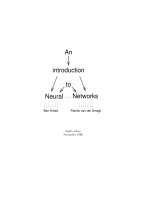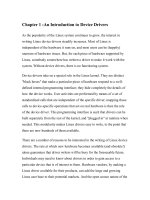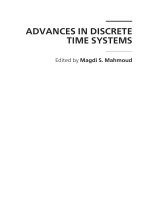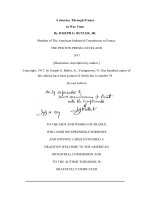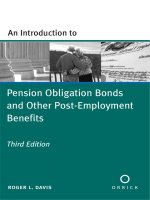Stochastic Finance An Introduction in Discrete Time ppt
Bạn đang xem bản rút gọn của tài liệu. Xem và tải ngay bản đầy đủ của tài liệu tại đây (2.34 MB, 474 trang )
de Gruyter Studies in Mathematics 27
Editors: Carlos Kenig · Andrew Ranicki · Michael Röckner
de Gruyter Studies in Mathematics
1 Riemannian Geometry, 2nd rev. ed., Wilhelm P. A. Klingenberg
2 Semimartingales, Michel Me
´
tivier
3 Holomorphic Functions of Several Variables, Ludger Kaup and Burchard Kaup
4 Spaces of Measures, Corneliu Constantinescu
5Knots, 2nd rev. and ext. ed., Gerhard Burde and Heiner Zieschang
6Ergodic Theorems, Ulrich Krengel
7Mathematical Theory of Statistics, Helmut Strasser
8Transformation Groups, Tammo tom Dieck
9 Gibbs Measures and Phase Transitions, Hans-Otto Georgii
10 Analyticity in Infinite Dimensional Spaces, Michel Herve
´
11 Elementary Geometry in Hyperbolic Space, Werner Fenchel
12 Transcendental Numbers, Andrei B. Shidlovskii
13 Ordinary Differential Equations, Herbert Amann
14 Dirichlet Forms and Analysis on Wiener Space, Nicolas Bouleau and
Francis Hirsch
15 Nevanlinna Theory and Complex Differential Equations, Ilpo Laine
16 Rational Iteration, Norbert Steinmetz
17 Korovkin-type Approximation Theory and its Applications, Francesco Altomare
and Michele Campiti
18 Quantum Invariants of Knots and 3-Manifolds, Vladimir G. Turaev
19 Dirichlet Forms and Symmetric Markov Processes, Masatoshi Fukushima,
Yoichi Oshima and Masayoshi Takeda
20 Harmonic Analysis of Probability Measures on Hypergroups, Walter R. Bloom
and Herbert Heyer
21 Potential Theory on Infinite-Dimensional Abelian Groups, Alexander Bendikov
22 Methods of Noncommutative Analysis, Vladimir E. Nazaikinskii,
Victor E. Shatalov and Boris Yu. Sternin
23 Probability Theory, Heinz Bauer
24 Variational Methods for Potential Operator Equations, Jan Chabrowski
25 The Structure of Compact Groups, Karl H. Hofmann and Sidney A. Morris
26 Measure and Integration Theory, Heinz Bauer
27 Stochastic Finance, 2nd rev. and ext. ed., Hans Föllmer and Alexander Schied
28 Painleve
´
Differential Equations in the Complex Plane, Valerii I. Gromak, Ilpo
Laine and Shun Shimomura
29 Discontinuous Groups of Isometries in the Hyperbolic Plane, Werner Fenchel
and Jakob Nielsen
30 The Reidemeister Torsion of 3-Manifolds, Liviu I. Nicolaescu
31 Elliptic Curves, Susanne Schmitt and Horst G. Zimmer
Hans Föllmer · Alexander Schied
Stochastic Finance
An Introduction in Discrete Time
Second Revised and Extended Edition
Walter de Gruyter
Berlin · New York
≥
Authors
Hans Föllmer
Institut für Mathematik
Humboldt Universität zu Berlin
Unter den Linden 6
10099 Berlin
Germany
Alexander Schied
Institut für Mathematik, MA 7Ϫ4
Technische Universität Berlin
Straße des 17. Juni 136
10623 Berlin
Germany
Series Editors
Carlos E. Kenig
Department of Mathematics
University of Chicago
5734 University Ave
Chicago, IL 60637
USA
Andrew Ranicki
School of Mathematics
University of Edinburgh
Mayfield Road
Edinburgh EH9 3JZ
Great Britain
Michael Röckner
Fakultät für Mathematik
Universität Bielefeld
Universitätsstraße 25
33615 Bielefeld
Germany
Mathematics Subject Classification 2000: Primary: 60-01, 91-01, 91-02; secondary: 46N10, 60E15,
60G40, 60G42, 91B08, 91B16, 91B28, 91B30, 91B50, 91B52, 91B70
Keywords: Martingales, arbitrage, contingent claims, options, hedging, preferences, optimization, equi-
librium, value at risk, risk measures
Ț
ȍ Printed on acid-free paper which falls within the guidelines of the ANSI
to ensure permanence and durability.
Library of Congress Ϫ Cataloging-in-Publication Data
Föllmer, Hans.
Stochastic finance : an introduction in discrete time / by Hans Föll-
mer, Alexander Schied.Ϫ 2nd rev. and extended ed.
p. cm. Ϫ (De Gruyter studies in mathematics ; 27)
Includes bibliographical references and index.
ISBN 3-11-018346-3 (Cloth : alk. paper)
1. Finance Ϫ Statistical methods. 2. Stochastic analysis. 3. Prob-
abilities. I. Schied, Alexander. II. Title. III. Series.
HG176.5.F65 2004
3321.011519232Ϫdc22 004021608
ISBN 3-11-018346-3
Bibliographic information published by Die Deutsche Bibliothek
Die Deutsche Bibliothek lists this publication in the Deutsche Nationalbibliografie;
detailed bibliographic data is available in the Internet at ϽϾ.
Ą Copyright 2004 by Walter de Gruyter GmbH & Co. KG, 10785 Berlin, Germany.
All rights reserved, including those of translation into foreign languages. No part of this book may be
reproduced in any form or by any means, electronic or mechanical, including photocopy, recording, or
any information storage and retrieval system, without permission in writing from the publisher.
Printed in Germany.
Cover design: Rudolf Hübler, Berlin.
Typeset using the authors’ T
E
X files: I. Zimmermann, Freiburg.
Printing and binding: Hubert & Co. GmbH & Co. KG, Göttingen.
Preface to the second edition
Since the publication of the first edition we have used it as the basis for several courses.
These include courses for a whole semester on Mathematical Finance in Berlin and
also short courses on special topics such as risk measures given at the Institut Henri
Poincaré in Paris, at the Department of Operations Research at Cornell University, at
theAcademia Sinica inTaipei, and at the 8thSymposiumon Probability and Stochastic
Processes in Puebla. In the process we have made a large number of minor corrections,
we have discovered many opportunities for simplification and clarification, and we
have also learned more about several topics. As a result, major parts of this book
have been improved or even entirely rewritten. Among them are those on robust
representations of risk measures, arbitrage-free pricing of contingent claims, exotic
derivatives in the CRR model, convergence to Black–Scholes prices, and stability
under pasting with its connections to dynamically consistent coherent risk measures.
In addition, this second edition contains several new sections, including a systematic
discussion of law-invariant risk measures, of concave distortions, and of the relations
between risk measures and Choquet integration.
It isapleasure to express our thanksto all studentsand colleagues whosecomments
have helped us to prepare this second edition, in particular to Dirk Becherer, Hans
Bühler, Rose-Anne Dana, Ulrich Horst, Mesrop Janunts, Christoph Kühn, Maren
Liese, Harald Luschgy, Holger Pint, Philip Protter, Lothar Rogge, Stephan Sturm,
Stefan Weber, Wiebke Wittmüß, and Ching-Tang Wu. Special thanks are due to Peter
Bank and to Yuliya Mishura and Georgiy Shevchenko, our translators for the Russian
edition. Finally, we thank IreneZimmermann and Manfred Karbeofde GruyterVerlag
for urging us to write a second edition and for their efficient support.
Berlin, September 2004 Hans Föllmer
Alexander Schied
Preface to the first edition
This book is an introduction to probabilistic methods in Finance. It is intended for
graduate students in mathematics, and it may also be useful for mathematicians in
academia and in the financial industry. Our focus is on stochastic models in discrete
time. This limitation has two immediate benefits. First, the probabilistic machinery
is simpler, and we can discuss right away some of the key problems in the theory
of pricing and hedging of financial derivatives. Second, the paradigm of a complete
financial market, where all derivatives admit a perfect hedge, becomes the exception
rather than the rule. Thus, the discrete-time setting provides a shortcut to some of the
more recent literature on incomplete financial market models.
As a textbook for mathematicians, it is an introduction at an intermediate level,
with special emphasis on martingale methods. Since it does not use the continuous-
time methods of Itô calculus, it needs less preparation than more advanced texts such
as [73], [74], [82], [129], [188]. On the other hand, it is technically more demanding
than textbooks such as [160]: We work on general probability spaces, and so the text
captures the interplay between probability theory and functional analysis which has
been crucial for some of the recent advances in mathematical finance.
The book is based on our notes for first courses in Mathematical Finance which
both of us are teaching in Berlin at Humboldt University and at Technical University.
These courses are designed for students in mathematics with some background in
probability. Sometimes, they are given in parallel to a systematic course on stochastic
processes. At other times, martingale methods in discrete time are developed in the
course, as they are in this book. Usually the course is followed by a second course on
Mathematical Finance in continuous time. There it turns out to be useful that students
are already familiar with some of the key ideas of Mathematical Finance.
The core of this book is the dynamic arbitrage theory in the first chapters of Part II.
When teaching a course, we found it useful to explain some of the main arguments
in the more transparent one-period model before using them in the dynamical setting.
So one approach would be to start immediately in the multi-period framework of
Chapter 5, and to go back to selected sections of Part I as the need arises. As an
alternative, one could first focus on the one-period model, and then move on to Part II.
We include inChapter2abrief introduction to the mathematical theoryof expected
utility, even though this is a classical topic, and there is no shortage of excellent
expositions; see, for instance, [138] which happens to be our favorite. We have three
reasons for including this chapter. Our focus in this book is on incompleteness, and
incompleteness involves, in one form or another, preferences in the face of risk and
uncertainty. We feel that mathematicians working in this area should be aware, at
least to some extent, of the long line of thought which leads from Daniel Bernoulli via
von Neumann–Morgenstern and Savage to some more recent developments which are
motivated by shortcomings of the classical paradigm. This is our first reason. Second,
viii Preface to the first edition
the analysis of risk measures has emerged as a major topic in mathematical finance,
and this is closely related to a robust version of the Savage theory. Third, but not least,
our experience is that this part of the course was found particularly enjoyable, both by
the students and by ourselves.
We acknowledge our debt and express our thanks to all colleagues who have
contributed, directly or indirectly, through their publications and through informal
discussions, to our understanding of the topics discussed in this book. Ideas and
methods developedby Freddy Delbaen, DarrellDuffie, NicoleEl Karoui, David Heath,
Yuri Kabanov, Ioannis Karatzas, Dimitri Kramkov, David Kreps, Stanley Pliska, Chris
Rogers, Steve Ross, Walter Schachermayer, Martin Schweizer, Dieter Sondermann
and Christophe Stricker play a key role in our exposition. We are obliged to many
others; for instance the textbooks [54], [73], [74], [116], and [143] were a great help
when we started to teach courses on the subject.
We are grateful to all those who read parts of the manuscript and made useful
suggestions, in particular to Dirk Becherer, Ulrich Horst, Steffen Krüger, Irina Penner,
and to Alexander Giese who designed some of the figures. Special thanks are due to
Peter Bank fora large number ofconstructive comments. We also express our thanksto
Erhan Çinlar, Adam Monahan, and Philip Protter for improving some of the language,
and to the Department of Operations Research and Financial Engineering at Princeton
University for its hospitality during the weeks when we finished the manuscript.
Berlin, June 2002 Hans Föllmer
Alexander Schied
Contents
Preface to the second edition v
Preface to the first edition vii
I Mathematical finance in one period 1
1 Arbitrage theory 3
1.1 Assets, portfolios, and arbitrage opportunities 3
1.2 Absence of arbitrage and martingale measures 6
1.3 Derivative securities 14
1.4 Complete market models 23
1.5 Geometric characterization of arbitrage-free models 27
1.6 Contingent initial data 31
2Preferences 44
2.1 Preference relations and their numerical representation 45
2.2 Von Neumann–Morgenstern representation 51
2.3 Expected utility 61
2.4 Uniform preferences 74
2.5 Robust preferences on asset profiles 86
2.6 Probability measures with given marginals 99
3 Optimality and equilibrium 108
3.1 Portfolio optimization and the absence of arbitrage 108
3.2 Exponential utility and relative entropy 116
3.3 Optimal contingent claims 125
3.4 Microeconomic equilibrium 137
4 Monetary measures of risk 152
4.1 Risk measures and their acceptance sets 153
4.2 Robust representation of convex risk measures 161
4.3 Convex risk measures on L
∞
171
4.4 Value at Risk 177
4.5 Law-invariant risk measures 183
4.6 Concave distortions 188
4.7 Comonotonic risk measures 195
4.8 Measures of risk in a financial market 203
4.9 Shortfall risk 212
x Contents
II Dynamic hedging 221
5 Dynamic arbitrage theory 223
5.1 The multi-period market model 223
5.2 Arbitrage opportunities and martingale measures 227
5.3 European contingent claims 234
5.4 Complete markets 245
5.5 The binomial model 248
5.6 Exotic derivatives 253
5.7 Convergence to the Black–Scholes price 259
6 American contingent claims 277
6.1 Hedging strategies for the seller 277
6.2 Stopping strategies for the buyer 282
6.3 Arbitrage-free prices 292
6.4 Stability under pasting 297
6.5 Lower and upper Snell envelopes 300
7 Superhedging 308
7.1 P -supermartingales 308
7.2 Uniform Doob decomposition 310
7.3 Superhedging of American and European claims 313
7.4 Superhedging with liquid options 322
8 Efficient hedging 333
8.1 Quantile hedging 333
8.2 Hedging with minimal shortfall risk 339
9 Hedging under constraints 350
9.1 Absence of arbitrage opportunities 350
9.2 Uniform Doob decomposition 357
9.3 Upper Snell envelopes 362
9.4 Superhedging and risk measures 369
10 Minimizing the hedging error 372
10.1 Local quadratic risk 372
10.2 Minimal martingale measures 382
10.3 Variance-optimal hedging 392
Appendix 399
A.1 Convexity 399
A.2 Absolutely continuous probability measures 403
A.3 Quantile functions 406
A.4 The Neyman–Pearson lemma 414
Contents xi
A.5 The essential supremum of a family of random variables 417
A.6 Spaces of measures 418
A.7 Some functional analysis 428
Notes 433
Bibliography 439
List of symbols 449
Index 451
Part I
Mathematical finance in one period
Chapter 1
Arbitrage theory
In this chapter, we study the mathematical structure of a simple one-period model of a
financial market. We consider a finite number of assets. Their initial prices at time t =
0 areknown, theirfuture pricesat timet = 1 aredescribed asrandom variables onsome
probability space. Trading takes place at time t = 0. Already in this simple model,
some basic principles of mathematical finance appear very clearly. In Section 1.2, we
single out those models which satisfy a condition of market efficiency: There are no
trading opportunities which yield a profit without any downside risk. The absence
of such arbitrage opportunities is characterized by the existence of an equivalent
martingale measure. Under such a measure, discounted prices have the martingale
property, that is, trading in the assets is the same as playing a fair game. As explained
in Section 1.3, any equivalent martingale measure can be identified with a pricing rule:
It extends the given prices of the primary assets to a larger space of contingent claims,
or financial derivatives, without creating new arbitrage opportunities. In general, there
will be several such extensions. A given contingent claimhas a unique price ifand only
if it admits a perfect hedge.Inour one-period model, this will be the exception rather
than the rule. Thus, we are facing market incompleteness, unless our model satisfies
the very restrictive conditions discussed in Section 1.4. The geometric structure of an
arbitrage-free model is described in Section 1.5.
The one-period market model will be used throughout the first part of this book.
On the one hand, its structure is rich enough to illustrate some of the key ideas of the
field. On the other hand, it will provide an introduction to some of the mathematical
methods which will be used in the dynamic hedging theory of the second part. In fact,
the multi-period situation considered in Chapter 5 can be regarded as a sequence of
one-period models whose initialconditions are contingent on the outcomesof previous
periods. The techniques for dealing with such contingent initial data are introduced
in Section 1.6.
1.1 Assets, portfolios, and arbitrage opportunities
Consider a financial market with d + 1 assets. The assets can consist, for instance,
of equities, bonds, commodities, or currencies. In a simple one-period model, these
assets are priced at the initial time t = 0 and at the final time t = 1. We assume that
the i
th
asset is available at time 0 for a price π
i
≥ 0. The collection
π = (π
0
,π
1
, ,π
d
) ∈ R
d+1
+
4 1 Arbitrage theory
is called a price system. Prices at time 1 are usually not known beforehand at time 0.
In order to model this uncertainty, we fix a probability space (, F ,P)and describe
the asset prices at time 1 as non-negative measurable functions
S
0
,S
1
, ,S
d
on (, F ) with values in [0, ∞).Every ω ∈ corresponds to a particular scenario
of market evolution, and S
i
(ω) is the price of the i
th
asset at time 1 if the scenario ω
occurs.
However, not all asset prices in a market are necessarily uncertain. Usually there
is a riskless bond which will pay a sure amount at time 1. In our simple model for one
period, such a riskless investment opportunity will be included by assuming that
π
0
= 1 and S
0
≡ 1 +r
for a constantr, the returnof a unit investment into the risklessbond. Inmost situations
it would be natural to assume r ≥ 0, but for our purposes it is enough to require that
S
0
> 0, or equivalently that
r>−1.
In order to distinguish S
0
from the risky assets S
1
, ,S
d
,itwill be convenient to
use the notation
S = (S
0
,S
1
, ,S
d
) = (S
0
,S),
and in the same way we will write
π = (1,π).
At time t = 0, an investor will choose a portfolio
ξ = (ξ
0
,ξ)= (ξ
0
,ξ
1
, ,ξ
d
) ∈ R
d+1
,
where ξ
i
represents the number of shares of the i
th
asset. The price for buying the
portfolio
ξ equals
π · ξ =
d
i=0
π
i
ξ
i
.
At time t = 1, the portfolio will have the value
ξ · S(ω) =
d
i=0
ξ
i
S
i
(ω) = ξ
0
(1 + r) + ξ ·S(ω),
depending on the scenario ω ∈ . Here we assume implicitly that buying and selling
assets does not create extra costs, an assumption which may not be valid for a small
investor but which becomes more realistic for a large financial institution. Note our
convention of writing x ·y for the inner product of two vectors x and y in Euclidean
space.
Our definition of a portfolio allows the components ξ
i
to be negative. If ξ
0
< 0,
this corresponds to taking out a loan such that we receive the amount |ξ
0
| at t = 0
1.1 Assets, portfolios, and arbitrage opportunities 5
and pay back the amount (1 +r)|ξ
0
| at time t = 1. If ξ
i
< 0 for i ≥ 1, a quantity of
|ξ
i
| shares of the i
th
asset is sold without actually owning them. This corresponds to
a short sale of the asset. In particular, an investor is allowed to take a short position
ξ
i
< 0, and to use up the received amount π
i
|ξ
i
| for buying quantities ξ
j
≥ 0, j = i,
of the other assets. In this case, the price of the portfolio
ξ = (ξ
0
,ξ) is given by
ξ · π = 0.
Definition 1.1. A portfolio
ξ ∈ R
d+1
is called an arbitrage opportunity if π · ξ ≤ 0
but
ξ · S ≥ 0 P -a.s. and P [ξ · S>0] > 0.
Intuitively, an arbitrage opportunity is an investment strategy that yields with
positive probability a positive profit and is not exposed to any downside risk. The
existence of such an arbitrage opportunity may be regarded as a market inefficiency
in the sense that certain assets are not priced in a reasonable way. In real-world
markets, arbitrage opportunities are rather hard to find. If such an opportunity would
show up, it would generate a large demand, prices would adjust, and the opportunity
would disappear. Later on, the absence of such arbitrage opportunities will be our
key assumption. Absence of arbitrage implies that S
i
vanishes P -a.s. once π
i
= 0.
Hence, there is no loss in generality if we assume from now on that
π
i
> 0 for i = 1, ,d.
Remark 1.2. Note that the probability measure P enters the definition of an arbitrage
opportunity only through the null sets of P .Inparticular, the definition can be for-
mulated without any explicit use of probabilities if is countable. In this case there
is no loss of generality in assuming that the underlying probability measure satisfies
P [{ω}] > 0 for every ω ∈ . Then an arbitrage opportunity is simply a portfolio
ξ
with
π · ξ ≤ 0, with ξ · S(ω) ≥ 0 for all ω ∈ , and such that ξ · S(ω
0
)>0 for at
least one ω
0
∈ . ♦
The following lemma shows that absence ofarbitrage is equivalent to the following
property of the market: Any investment in risky assets which yields with positive
probability a better result than investing the same amount in the risk-free asset must
be open to some downside risk.
Lemma 1.3. The following statements are equivalent.
(a) The market model admits an arbitrage opportunity.
(b) There is a vector ξ ∈ R
d
such that
ξ · S ≥ (1 + r)ξ · πP-a.s. and P [ξ ·S>(1 + r)ξ ·π ] > 0.
Proof. To see that (a) implies (b), let
ξ be an arbitrage opportunity. Then 0 ≥ ξ ·π =
ξ
0
+ ξ · π. Hence,
ξ · S −(1 + r)ξ ·π ≥ ξ · S + (1 +r)ξ
0
= ξ · S.
6 1 Arbitrage theory
Since ξ ·S is P -a.s. non-negative and strictly positive with non-vanishing probability,
the same must be true of ξ · S −(1 + r)ξ ·π .
Next let ξ be as in (b). We claim that the portfolio (ξ
0
,ξ) with ξ
0
:= −ξ · π is
an arbitrage opportunity. Indeed,
ξ · π = ξ
0
+ ξ · π = 0bydefinition. Moreover,
ξ ·S =−(1 + r)ξ · π +ξ ·S, which is P -a.s. non-negative and strictly positive with
non-vanishing probability.
1.2 Absence of arbitrage and martingale measures
In this section, we are going to characterize those market models which do not admit
any arbitrage opportunities. Such models will be called arbitrage-free.
Definition 1.4. A probability measure P
∗
is called a risk-neutral measure,oramar-
tingale measure,if
π
i
= E
∗
S
i
1 + r
,i= 0, 1, ,d. (1.1)
Remark 1.5. In (1.1), the price of the i
th
asset is identified as the expectation of
the discounted payoff under the measure P
∗
. Thus, the pricing formula (1.1) can
be seen as a classical valuation formula which does not take into account any risk
aversion, in contrast to valuations in terms of expected utility which will be discussed
in Section 2.3. This is why a measure P
∗
satisfying (1.1) is called risk-neutral. The
connection to martingales will be made explicit in Section 1.6. ♦
The following basic result is sometimes called the “fundamental theorem of asset
pricing” or, in short, FTAP. It characterizes arbitrage-free market models in terms of
the set
P :=
P
∗
| P
∗
is a risk-neutral measure with P
∗
≈ P
of risk-neutral measures which are equivalent to P . Recall that two probability mea-
sures P
∗
and P are said to be equivalent (P
∗
≈ P ) if, for A ∈ F , P
∗
[A ]=0if
and only if P [A ]=0. This holds if and only if P
∗
has a strictly positive density
dP
∗
/dP with respect to P ; see Appendix A.2. An equivalent risk-neutral measure is
also called a pricing measure or an equivalent martingale measure.
Theorem 1.6. A market model is arbitrage-free if and only if P =∅.Inthis case,
there exists a P
∗
∈ P which has a bounded density dP
∗
/dP .
We show first that the existence of a risk-neutral measure implies the absence of
arbitrage.
Proof of the implication ⇐ of Theorem 1.6. Suppose that there exists a risk-neutral
measure P
∗
∈ P .Take a portfolio ξ ∈ R
d+1
such that ξ · S ≥ 0 P -a.s. and
1.2 Absence of arbitrage and martingale measures 7
E[
ξ ·S ] > 0. Both properties remain valid if we replace P by the equivalent measure
P
∗
. Hence,
π ·
ξ =
d
i=0
π
i
ξ
i
=
d
i=0
E
∗
ξ
i
S
i
1 + r
= E
∗
ξ · S
1 + r
> 0.
Thus,
ξ cannot be an arbitrage opportunity.
For the proof of the implication ⇒ of Theorem 1.6, it will be convenient to
introduce the random vector Y = (Y
1
, ,Y
d
) of discounted net gains:
Y
i
:=
S
i
1 + r
− π
i
,i= 1, ,d. (1.2)
With this notation, Lemma 1.3 implies that the absence of arbitrage is equivalent to
the following condition:
For ξ ∈ R
d
: ξ · Y ≥ 0 P -a.s. ⇒ ξ · Y = 0 P -a.s. (1.3)
Since Y
i
is bounded from below by −π
i
, the expectation E
∗
[Y
i
] of Y
i
under any
measure P
∗
is well-defined, and so P
∗
is a risk-neutral measure if and only if
E
∗
[Y ]=0. (1.4)
Here, E
∗
[Y ] is a shorthand notation for the d-dimensional vector with components
E
∗
[Y
i
], i = 1, ,d. The assertion of Theorem 1.6 can now be read as follows:
Condition (1.3) holds if and only if there exists some P
∗
≈ P such that E
∗
[Y ]=0,
and in this case, P
∗
can be chosen such that the density dP
∗
/dP is bounded.
Proof of the implication ⇒ of Theorem 1.6. We have to show that (1.3) implies the
existence of some P
∗
≈ P such that (1.4) holds and such that the density dP
∗
/dP is
bounded. We will do this first in the case in which
E[|Y |]< ∞.
Let Q denote the convex set of all probability measures Q ≈ P with bounded
densities dQ/dP , and denote by E
Q
[Y ] the d-dimensional vector with components
E
Q
[Y
i
], i = 1, ,d. Due to our assumption that |Y |∈L
1
(P ), all these expecta-
tions are finite. Let
C := {E
Q
[Y ]|Q ∈ Q },
and note that C is a convex set in R
d
:IfQ
1
, Q
0
∈ Q and 0 ≤ α ≤ 1, then
Q
α
:= αQ
1
+ (1 − α)Q
0
∈ Q and
αE
Q
1
[Y ]+(1 − α)E
Q
0
[Y ]=E
Q
α
[Y ],
which lies in C.
8 1 Arbitrage theory
Our aim is to show that C contains the origin. To this end, we suppose by way of
contradiction that0 /∈ C. Using the“separating hyperplanetheorem” inthe elementary
form of Proposition A.1, we obtain a vector ξ ∈ R
d
such that ξ ·x ≥ 0 for all x ∈ C,
and such that ξ · x
0
> 0 for some x
0
∈ C. Thus, ξ satisfies E
Q
[ξ · Y ]≥0 for all
Q ∈ Q and E
Q
0
[ξ · Y ] > 0 for some Q
0
∈ Q. Clearly, the latter condition yields
that P [ξ · Y>0 ] > 0. We claim that the first condition implies that ξ · Y is P -a.s.
non-negative. This fact will be a contradiction to our assumption (1.3) and thus will
prove that 0 ∈ C.
To prove the claim that ξ ·Y ≥ 0 P -a.s., let A := {ξ ·Y<0}, and define functions
ϕ
n
:=
1 −
1
n
· I
A
+
1
n
· I
A
c
.
We take ϕ
n
as densities for new probability measures Q
n
:
dQ
n
dP
:=
1
E[ϕ
n
]
· ϕ
n
,n= 2, 3,
Since 0 <ϕ
n
≤ 1, it follows that Q
n
∈ Q, and thus that
0 ≤ ξ ·E
Q
n
[Y ]=
1
E[ϕ
n
]
E[ξ · Yϕ
n
].
Hence, Lebesgue’s dominated convergence theorem yields that
E
ξ · Y I
{ξ ·Y<0 }
= lim
n↑∞
E[ξ · Yϕ
n
]≥0.
This proves the claim that ξ · Y ≥ 0 P -a.s. and completes the proof of Theorem 1.6
in case E[|Y |]< ∞.
If Y is not P -integrable, then we simply replace the probability measure P by
a suitable equivalent measure
P whose density d
P/dP is bounded and for which
E[|Y |]< ∞.For instance, one can define
P by
d
P
dP
=
c
1 +|Y|
for c :=
E
1
1 +|Y|
−1
.
Recall from Remark 1.2 that replacing P with an equivalent probability measure does
not affect the absence of arbitrage opportunities in our market model. Thus, the first
part of this proof yields a risk-neutral measure P
∗
which is equivalent to
P and whose
density dP
∗
/d
P is bounded. Then P
∗
∈ P , and
dP
∗
dP
=
dP
∗
d
P
·
d
P
dP
is bounded. Hence, P
∗
is as desired, and the theorem is proved.
1.2 Absence of arbitrage and martingale measures 9
Remark 1.7. Our assumption that asset prices are non-negative implies that the com-
ponents of Y are bounded from below. Note however that this assumption was not
needed in our proof. Thus, Theorem 1.6 also holds if we only assume that S is finite-
valued and π ∈ R
d
.Inthis case, the definition of a risk-neutral measure P
∗
via
(1.1) is meant to include the assumption that S
i
is integrable with respect to P
∗
for
i = 1, ,d. ♦
Example 1.8. Let P be any probability measure on the finite set := {ω
1
, ,ω
N
}
that assigns strictly positive probability p
i
to each singleton {ω
i
}. Suppose that there
is a single risky asset defined by its price π = π
1
at time 0 and by the random variable
S = S
1
.Wemay assume without loss of generality that the values s
i
:= S(ω
i
) are
distinct and arranged in increasing order: s
1
< ···<s
N
. According to Theorem 1.6,
this model does not admit arbitrage opportunities if and only if
π(1 + r) ∈{
E[S ]|
P ≈ P }=
N
i=1
s
i
p
i
p
i
> 0,
N
i=1
p
i
= 1
= (s
1
,s
N
),
and P
∗
is a risk-neutral measure if and only if the probabilities p
∗
i
:= P
∗
[{ω
i
}]solve
the linear equations
s
1
p
∗
1
+ ···+s
N
p
∗
N
= π(1 + r),
p
∗
1
+ ···+p
∗
N
= 1.
If a solution exists, it will be unique if and only if N = 2, and there will be infinitely
many solutions for N>2. ♦
Remark 1.9. The economic reason for working with the discounted asset prices
X
i
:=
S
i
1 + r
,i= 0, ,d, (1.5)
is that one should distinguish between one unit of a currency (e.g. €)attime t = 0
and one unit at time t = 1. Usually people tend to prefer a certain amount today over
the same amount which is promised to be paid at a later time. Such a preference is
reflected in an interest r>0 paid by the riskless bond: Only the amount 1/(1 + r)€
must be invested at time 0 to obtain 1 € at time 1. This effect is sometimes referred to
as the time value of money. Similarly, the price S
i
of the i
th
asset is quoted in terms
of € at time 1, while π
i
corresponds to time-zero euros. Thus, in order to compare
the two prices π
i
and S
i
, one should first convert them to a common standard. This is
achieved by taking the riskless bond as a numéraire and by considering the discounted
prices in (1.5). ♦
Remark 1.10. One can choose as numéraire any asset which is strictly positive. For
instance, suppose that π
1
> 0 and P [S
1
> 0 ]=1. Then all asset prices can be
expressed in units of the first asset by considering
π
i
:=
π
i
π
1
and
S
i
S
1
,i= 0, ,d.
10 1 Arbitrage theory
Clearly, the definition of an arbitrage opportunity is independent of the choice of a
particular numéraire. Thus, an arbitrage-freemarket model should admit arisk-neutral
measure with respect to the new numéraire, i.e., a probability measure
P
∗
≈ P such
that
π
i
=
E
∗
S
i
S
1
,i= 0, ,d.
Let us denote by
P the set of all such measures
P
∗
. Then
P =
P
∗
d
P
∗
dP
=
S
1
E
∗
[S
1
]
for some P
∗
∈ P
.
Indeed, if
P
∗
lies in the set on the right, then
E
∗
S
i
S
1
=
E
∗
[S
i
]
E
∗
[S
1
]
=
π
i
π
1
= π
i
,
and so
P
∗
∈
P .Reversing the roles of
P and P then yields the identity of the two
sets. Note that
P ∩
P =∅
as soon as S
1
is not P -a.s. constant, because Jensen’s inequality then implies that
1
π
1
= π
0
=
E
∗
1 + r
S
1
>
1 + r
E
∗
[S
1
]
and hence
E
∗
[S
1
] >E
∗
[S
1
] for all
P
∗
∈
P and P
∗
∈ P . ♦
Let
V :=
ξ · S | ξ ∈ R
d+1
denote the linear space of all payoffs which can be generated by some portfolio. An
element of V will be called an attainable payoff. The portfolio that generates V ∈ V
is in general not unique, but we have the following law of one price.
Lemma 1.11. Suppose that the market model is arbitrage-free and that V ∈ V can
be written as V =
ξ · S = ζ · SP-a.s. for two different portfolios ξ and ζ . Then
π · ξ = π · ζ.
Proof. We have (ξ − ζ)· S = 0 P
∗
-a.s. for any P
∗
∈ P . Hence,
π · ξ − π · ζ = E
∗
(
ξ − ζ)· S
1 + r
= 0,
due to (1.1).
By the preceding lemma, it makes sense to define the price of V ∈ V as
π(V) :=
π ·
ξ if V = ξ ·S, (1.6)
whenever the market model is arbitrage-free.
1.2 Absence of arbitrage and martingale measures 11
Remark 1.12. Via (1.6), the price system π can be regarded as a linear form on the
finite-dimensional vector space V.Forany P
∗
∈ P we have
π(V) = E
∗
V
1 + r
,V∈ V.
Thus, an equivalent risk-neutral measure P
∗
defines a linear extension of π onto the
larger space L
1
(P
∗
) of P
∗
-integrable random variables. Since this space is usually
infinite-dimensional, one cannot expect that such a pricing measure is in general
unique; see however Section 1.4. ♦
We have seen above that, in an arbitrage-free market model, the condition
ξ ·S = 0
P -a.s. implies that
π ·ξ = 0. In fact, one may assume without loss of generality that
ξ · S = 0 P -a.s. ⇒ ξ = 0, (1.7)
for otherwise we can find i ∈{0, ,d} such that ξ
i
= 0 and represent the i
th
asset
as a linear combination of the remaining ones:
π
i
=
1
ξ
i
j=i
ξ
j
π
j
and S
i
=
1
ξ
i
j=i
ξ
j
S
j
.
In this sense, the i
th
asset is redundant and can be omitted.
Definition 1.13. The market model is called non-redundant if (1.7) holds.
Remark 1.14. In any non-redundant market model, the components of the vector Y
of discounted net gains are linearly independent in the sense that
ξ · Y = 0 P -a.s. ⇒ ξ = 0. (1.8)
Conversely, via (1.3), condition (1.8) implies non-redundance if the market model is
arbitrage-free. ♦
Definition 1.15. Suppose that the market model is arbitrage-free and that V ∈ V is
an attainable payoff such that π(V) = 0. Then the return of V is defined by
R(V ) :=
V − π(V )
π(V)
.
Note that we have already seen the special case of the risk-free return
r =
S
0
− π
0
π
0
= R(S
0
).
If an attainable payoff V is a linear combination V =
n
k=1
α
k
V
k
of non-zero attain-
able payoffs V
k
, then
R(V ) =
n
k=1
β
k
R(V
k
) for β
k
=
α
k
π(V
k
)
n
i=1
α
i
π(V
i
)
.
12 1 Arbitrage theory
The coefficient β
k
can be interpreted as the proportion of the investment allocated to
V
k
.Asaparticular case of the formula above, we have that
R(V ) =
d
i=0
π
i
ξ
i
π · ξ
· R(S
i
)
for all non-zero attainable payoffs V =
ξ · S (recall that we have assumed that all π
i
are strictly positive).
Proposition 1.16. Suppose that the market model is arbitrage-free, and let V ∈ V be
an attainable payoff such that π(V) = 0.
(a) Under any risk-neutral measure P
∗
, the expected return of V is equal to the
risk-free return r:
E
∗
[R(V )]=r.
(b) Under any measure Q ≈ P such that E
Q
[|S|]< ∞, the expected return of V
is given by
E
Q
[R(V )]=r −cov
Q
dP
∗
dQ
,R(V)
,
where P
∗
is an arbitrary risk-neutral measure in P and cov
Q
denotes the
covariance with respect to Q.
Proof. (a): Since E
∗
[V ]=π(V)(1 + r),wehave
E
∗
[R(V )]=
E
∗
[V ]−π(V)
π(V)
= r.
(b): Let P
∗
∈ P and ϕ
∗
:= dP
∗
/dQ. Then
cov
Q
ϕ
∗
,R(V)
= E
Q
[ϕ
∗
R(V )]−E
Q
[ϕ
∗
]·E
Q
[R(V )]
= E
∗
[R(V )]−E
Q
[R(V )].
Using part (a) yields the assertion.
Remark 1.17. Let us comment on the extension of the fundamental equivalence in
Theorem 1.6 to market models with an infinity of tradable assets S
0
,S
1
,S
2
, We
assume that S
0
≡ 1 +r for some r>−1 and that the random vector
S(ω) =
S
1
(ω), S
2
(ω),
takes values in the space
∞
of bounded real sequences. This space is a Banach space
with respect to the norm
x
∞
:= sup
i≥1
|x
i
| for x = (x
1
,x
2
, )∈
∞
.
